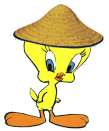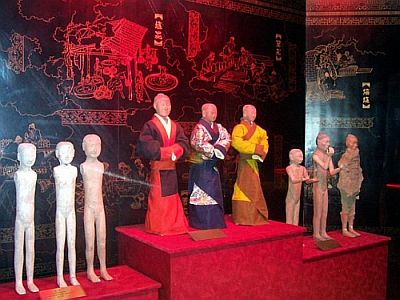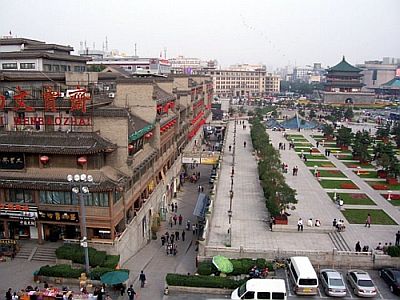
China
Xi'an, "the western peace"![[Unesco]](/images/unesco-logo.gif)
![[+]](/images/icone-etoile.png)
One of the kingdoms of China, the State of Qin (pronounced T'chin), established its capital at Xianyang, in the north of the present city, around 350 B.C. The last emperor of this dynasty, named Qin Shi Huangdi, unified China with the conquest of the 6 neighboring kingdoms in the third century B.C. But after his death in -210 a war of succession began sweeping away both his capital and his dynasty. Liu Bang, first emperor of the next dynasty (Han), established his new capital at Chang'an, "constant peace", located further south. It took the name of Xi'an, "the western peace" in the 14th century under the Ming. Previously, it experienced a golden age under the Tang (618-907 A.D., who succeeded the Han and Sui) being the starting point of the Silk Road and drawing several religious communities : Buddhists, Christians (Nestorians), Muslims... After the fall of the Tang dynasty (prosperous and tolerant at first but during which there were persecution of followers of foreign religions such as Buddhism and Christianity in the 9th century) the town gradually lost its importance. She became once again famous after the discovery of the terracotta buried army of emperor Qin in the '70s.
The buried army of emperor Qin, the first emperor of China

More than 500,000 people, involving many trades, worked on the tomb of the emperor by setting
thousands of terracotta warriors ! The emperor, who feared death, ordered this work as soon as
he came to the throne at the age of 13. The work lasted 36 years until his death...
The statues of 1.70 m (5.7 feet) to 1.90 m (6.3 feet) represent life size warriors although slightly higher than the size of
people of that time. They were painted and could be accompanied by terracotta horses : there were
riders, archers and infantry. Every face, hair and expression is unique !
This is unbelievable and one of the most important site in China with the Great Wall (already ordered by the emperor Qin !) and the forbidden city.
Once there, we can also watch short films including an interesting one in a 360┬░ panoramic.
In addition to this, the tomb of Qin, a little away from the buried army and under a mound would consist of an arch of glittering precious stones and a sea of mercury (no less !) on which float the sarcophagus of the emperor... all this in the conditional as it is still unexplored, partly because the question arises about the possible emanation of a large amount of mercury if an opening was made in the tomb. The hypothesis of the presence of mercury seems to be taken seriously by archaeologists because of measures showing that mercury levels are higher than normal near the site...
Han Yangling mausoleum
It was definitely a habit ! An emperor from the next dynasty (Han), emperor Jingdi, had also built a tomb with hundreds of terracotta warriors and characters of his court, but those of small size, around 60 cm (2 feet) tall. They had wooden arms (in order to be articulated) and clothes. We can still distinguish the sex of the figurines (male or female) and even recognize the eunuchs... There were also many terracotta animals.
These figurines have been discovered recently in 1990 when building a road leading to the airport, close to the site. ![]() Access info
Access info
There is no direct line to get there. There are two buses line No.4 : one being the terminus of the other so better ask for direction. From the station : line 228 until the third stop and then line 4 (until the first terminus then next line 4 until the last terminus near the museum).

Famen Si pagoda
It is worth seeing as it is a shrine to Buddha Sakyamuni but the trip is 2h by bus from the station, and adding the visit and lunch, it almost takes all the day => not done because of lack of time...
The city of Xi'an

To be seen : the walls (e.g. near the south gate), the bell tower, the drum tower, the hui district (Chinese
Muslims) and its great mosque built in the 8th century during the Tang, the forest of steles.
Extra muros : small and large wild goose pagoda (not seen).
A word about the forest of steles... As its name suggests, they are steles, most from the 9th
century, with Confucius texts inscribed in ideograms during the Tang period. They were
placed in an ancient temple of Confucius in the 11th century to protect them. One of them, the "stele
of Xi'an", speaks of the Nestorian branch of Christianity. The Nestorians, Eastern Christians, arrived in
China in the early 7th century and thus were probably the first Christians of China, long before the
Jesuit Matteo Ricci (16th century). They had a different approach of the nature of Christ than
the Roman Church. Their religion disappeared from China in the 9th century.
It is likely that this community inspired
the legend of Prester John in the West during the twelfth century; according to this legend, a Christian priest called John, lived in the Far East where he fought and
defeated the Persians. Many explorations tried to discover the kingdom of Prester John. In fact one of these explorations led by Portuguese discovered another
Christian land in Ethiopia in 1490.
See also, the stele "image" of Confucius, more "recent" as dating from 1734.
We can attend
to the achievement of copies made by stamping (technology widely used in Xi'an).
Farther away, there is a gallery of sculptures including a huge rhinoceros (rather unusual) from a mausoleum,
sculptures of horses, and an intact tomb of a Han emperor.
One can easily spend four days in Xi'an. There is also mount Huashan and a zoo.
